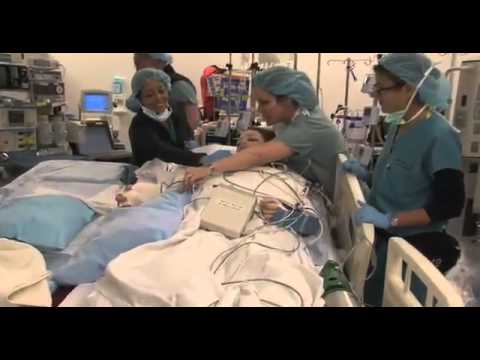Incredible Video of California Woman’s Hand Transplant

Share

Can you spot which hand Emily Fennell was born with, and which was recently attached? Hint: the bandage is the only real give away.
The latest recipient of a hand transplant is coping well in Los Angeles. On March 5th, Emily Fennel, age 26, received a donor right hand to replace the one she lost nearly five years earlier in a car accident. Now, more than six weeks later, she once again has two working hands and is on the road back to a normal life. In the weeks and months ahead, Fennel will continue to undergo occupational therapy - picking up small objects and relearning how to use her right hand. Doctors think she'll one day have as much as 60% of the functionality of her original limb. You can see Emily discuss her condition before and after the transplant in the videos at the bottom. With more than a dozen cases in the US, and over 40 worldwide, these transplants are slowly becoming a more common procedure...but seeing doctors attach a new hand to Emily's arm still seems utterly incredible!
In order to transplant the new hand onto Fennel's arm, surgeons had to connect 23 tendons, 2 bones, 2 arteries, and at least 3 nerves. The connection was made along a skewed ellipse, rather than a circle like a bracelet. This was to ensure that scar tissue didn't create a ring at the wrist that would impair movement or healing. While Fennel is reportedly adjusting well to the transplant, at this point in the recovery process she has no feeling in the attached hand. The connected nerves grow slowly (~1 millimeter per day) and so it will take many more weeks or months before she can receive sensations from the new limb. This numbness, however, has not stopped her from training to rebuild atrophied muscles in her arm and dexterity in her hand.
Hand transplants are extraordinary works of surgical finesse, but they come with a high price. Fennel will have to spend the rest of her life on immunosuppressant drugs to keep her body from rejecting the donor tissue. Those medications increase risks for high blood pressure, liver damage, kidney damage, cancer, and body wide infections.
Despite these dangers, Fennell is not alone in pursuing hand transplants at UCLA. The UCLA Hand Transplantation Program is still seeking prospective patients for the procedure, and while eligibility is limited, and the screening process rigorous (involving medical and psychological tests), I'm sure many will pursue entry into the program. Especially as the first success, Fennell, seems very happy with the results of her transplant.
The general field of transplants has become increasingly bold in the past few years, which has paid off with remarkable successes. We've seen several double hand transplants, as well as full face transplants. With stem cells, we've seen new organs grown inside patients using nothing more than their own cells and a donated 'scaffold' of the organ. Combined with Emily Fennell's recent surgery, these accomplishments paint a picture of a field of medicine that is accomplishing tasks that would have seen impossible a few decades ago. In the next few years, some of these surgeries could become almost common.
That's assuming, of course, that they don't get replaced by something better. While Fennell decided that prosthetics weren't the right solution for her amputation, others have chosen that route. We've seen how not only are robotic limbs becoming more adept, the most advanced prototypes are able to provide sensory feedback. As hand transplant surgeries improve in the years ahead, so too will these robotic alternatives. How long until they become as good as the biological versions? Fennell was able to find a near perfect match for her missing hand, but what about all the amputees who aren't so fortunate? Whether it's due to hopes of augmentation (eventually robotic limbs will surpass biological ones, even if takes fifty years) or a limit in opportunity, I think prosthetics will continue to be a strong solution for amputees even as hand transplants improve. If I had to weight the risks of immunosuppressant drugs versus the comfort of having a biological hand...I'm not sure how I would decide.
The beautiful thing is that patients can decide. We have options for amputees that simply weren't available a generation ago. Advanced robotic hands or waiting for a biological replacement - these are both pretty amazing options. Someday in the future we'll probably be able to add 'grow a new hand from your own stem cells'. Fennell's success with her new limb is another sign that we live in an extraordinary age. Medical technology keeps improving, and as it continues on its accelerated trajectory there may soon be no injury that we cannot repair, no tissue that we cannot replace, and no one that we cannot help.
The video below is a brief overview of Fennel's story, with a focus on the most recent updates on her condition. Her recovery is amazing.
Be Part of the Future
Sign up to receive top stories about groundbreaking technologies and visionary thinkers from SingularityHub.


This final video focuses on the surgery itself, which took place March 4th and 5th over 14 hours.
Image credit: ucla health system/ann johannson photography
Related Articles

Single Injection Transforms the Immune System Into a Cancer-Killing Machine

This Light-Powered AI Chip Is 100x Faster Than a Top Nvidia GPU

This Week’s Awesome Tech Stories From Around the Web (Through December 20)
What we’re reading